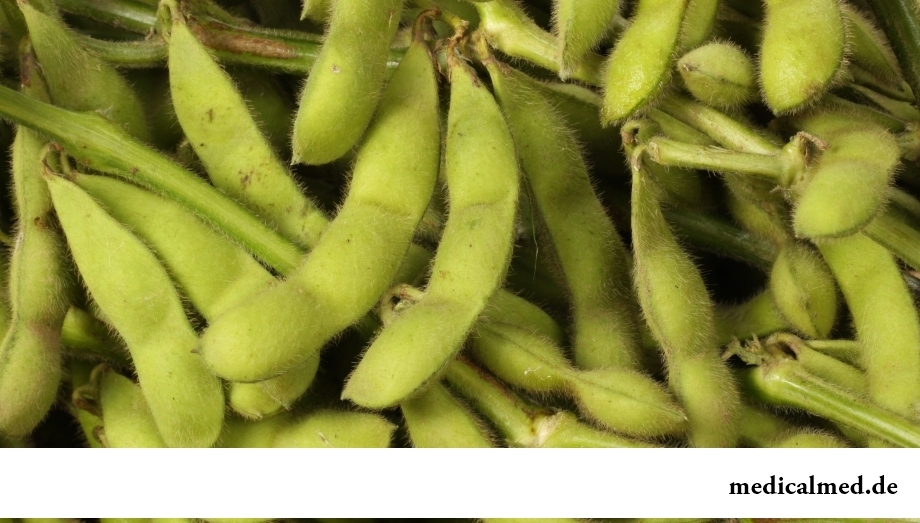





Soy
Soy – a cultivated plant of family Bean. It is cultivated in Southern Europe, Asia, South and North America, in South Africa, Australia and some islands of the Indian and Quiet oceans.

Seeds of soy are known as "soybeans" and more than four thousand years are widely applied in cookery already. The popularity soy deserved thanks to existence of the following signs:
- High degree of productivity;
- High content of protein (to 50%) which structure is similar to proteins of animal origin (milk and meat);
- Structure, vitamin-rich groups B, microelements, polyunsaturated fatty acids;
- Possibility of use as medical and prophylactic at a number of diseases;
- Absence as a part of cholesterol and low percentage of saturated fats;
- Is a raw basis for production of the widest range of food stuffs, soy milk, soy meat, etc. are basic of which.
Such properties allow to use soy as inexpensive, effective and useful substitute of dairy products and meat. It is remarkable that quite often preference such products are given not owing to economy (though products from soy in some cases are really cheaper milk and meat), and on the basis of other reasons (veganism, for example).
Soy is also included in structure of forages for young growth of agricultural animals.
Historians claim that for the first time soy began to be cultivated in China from where later it got to Korea and Japan. Among the countries of Europe soy was tried for the first time by French at the end of the 18th century.
In our country the first references of soy belong to the 40th years of the 17th century. The feather of the Russian traveler V. Poyarkov who, having visited an expedition near the Sea of Okhotsk, described properties of this product possesses them. However only at the end of the 19th century in Russia there was a practical interest in this culture.
Recently the advantage of soy became a reason for emergence of disputes as even more often it is possible to meet genetically changed version of this culture as a part of this or that product.
Nutrition value, structure and caloric content of soy
The main component of soy is protein which content, according to various authors, can vary, remaining ranging from 38 to 50%. The structure of soy proteins is heterogeneous, however about 70% from them are well acquired by an organism.
The amount of fats in beans of soy can reach 27%, however this level does not fall lower than 16%. On the content of phospholipids soy bypasses other cultivated plants. Despite rather high content of saturated fatty acids (about 13-14%), their quantity nevertheless it is less, than in animal fats where reaches 60%. The percentage ratio of unsaturated fatty acids at the same time equals 87% of total number.
With soy irreplaceable linolic acid which is not synthesized by an organism, and also tokoferola by which quantity soy oil is a champion arrives.
Carbohydrates in soy are presented by soluble sugars and polysaccharides. Their mass fraction makes about 30 g on 100 g of a product.
Beans of this plant also contain rare products – the isoflavones having oestrogenic activity.
Micro and the macrocells which are a part of seeds of soy: phosphorus, potassium, magnesium, calcium, silicon, sulfur, chlorine, sodium, iron, boron, manganese, aluminum, nickel, copper, molybdenum, iodine and cobalt.
The vitamins which are contained in soybeans: E, B6, PP, B3, B1, B2, and also sincaline, folic acid and biotin.
Caloric content of soy differs depending on bean maturity degree. So, in 100 g of green beans of soy 147 kcal, and in mature – already 446 Kcal on 100 g contain.
The increased soy caloric content at mature age of beans is connected with the fact that seeds saved up enough proteins and carbohydrates.
Useful properties of soy
In spite of the fact that beans of this plant possess an enormous set of useful substances, the advantage of soy is not unambiguous.
Content of full proteinaceous connections, nutritiousness not inferior to proteins of animal origin, is combined with the low content of saturated fatty acids, than meat and dairy products is so rich. From this point of view soy is a fine basis for a diet.
The phospholipids which are a part of beans of soy participate in regeneration of cellular membranes and increase detoksikatsionny ability of cells of a liver, performing also function of antioxidants. Besides, phospholipids allow to reduce need of patients with a diabetes mellitus for insulin, considerably reduce probability of degenerative changes in nervous cells and muscles and strengthen vessels.
Content of lecithin promotes acceleration of processes of exchange of fats and cholesterol, helps excesses of fats to burn down with a liver quicker. Besides, this phospholipid has lipotropic and cholagogue effect.
Polyunsaturated fatty acids as a part of soybeans are peculiar predecessors of gormonopodobny substances which interfere with accumulation of cholesterol in walls of vessels that, in turn, could lead to formation of atherosclerosis.
Enormous content of tocopherol in soy increases protective potencys of an organism, slows down aging processes, and also raises a potentiality.
Surprising property of soy to have radio tire-tread effect allows to use it as the means connecting ions of heavy metals in an organism.
Specialists claim that the soy use considerably reduces risk of development of obesity, allergy, osteoporosis, and also heart troubles. The advantage of soy is invaluable also to the patients who had a myocardial infarction, having atherosclerosis, a hypertension, an ischemic disease.

Harmful properties of soy
Soy not always, unfortunately, brings only benefit to an organism.
Full replacement of animal protein with soy leads to development of insufficiency of functions of a thyroid gland and to a stunt at children. As showed researches, soy quite often causes hormonal changes in an organism. In this regard products on its basis are contraindicated to pregnant women.
The excessive use of products from soy involves developing of rhinitis, dermatitis, asthma, diarrhea, eczema and some other diseases.
It is necessary to be attentive to the fans of soy inclined to formation of stones in kidneys as the use of a product is capable to provoke palindromias and to worsen the general condition of kidneys.
People who got used to have breakfast regularly have obesity much less often.

The naturopathy sometimes moves as the new direction of medicine, something like fashionable hobby, and there is nothing farther from the truth....
Section: Articles about health
From the failure of work of immune system which is shown in the form of an allergy, statistically, more than 40% of the population of the globe suffer. In most cases pathological reactions cause the substances which are contained in food stuffs, hair of animals, medicines...
Section: Articles about health
One of the major chemical processes happening in a human body are oxidation reactions. They go with participation of fats and carbohydrates which we receive from food, and the oxygen getting to us from air. A main goal of such reactions is obtaining the energy necessary for life activity. Unfortunately, as a result of these processes dangerous by-products – so-called free radicals are allocated. To minimize harm which they can cause to the person neo...
Section: Articles about health
Phobia – the persuasive fear of a certain contents shown in a specific situation against the will of the person. Concepts of a phobia and fear...
Section: Articles about health
All got used long ago that, having addressed the plastic surgeon, it is possible to modify natural parameters of a figure or to minimize the damages put to appearance with ruthless time. Many people (preferential women) worldwide е...
Section: Articles about health
The medicine promptly develops, and the fact that else quite recently it seemed by miracle can now. We are not surprised any more to the fact that people with artificial joints and extremities can play sports, organ transplantation became a routine, and the latest cancer medicine allowed to achieve reduction of mortality in tens of times. Miracles of plastic surgery thanks to which people in 60 years are in the flower of beauty and freshness, too not a sensation any more....
Section: Articles about health
Transfusion of donor blood has almost century history. In spite of the fact that this procedure is quite usual for many people, itself п...
Section: Articles about health
Practice of use of table salt in the therapeutic purposes contains not one century. Applications which do by means of the fabric impregnated with saline solution are considered especially effective. They possess antibacterial and antiinflammatory эффек...
Section: Articles about health
Partial and the more so full loss of hearing significantly reduces quality of life. Difficulties with communication lead to loneliness and isolation. The person who badly hears experiences difficulties with social and professional implementation, quite often has problems in private life....
Section: Articles about health
Healthy lifestyle today in fashion, and many parents think of that the child from the early childhood played sports. To a Torah...
Section: Articles about health
The brain of the person is studied not one hundred years, but the quantity of the riddles connected with this body increases rather, than decreases. Perhaps, numerous delusions concerning a structure and functioning of a brain, many are explained by it from...
Section: Articles about health
Sometimes it seems that modern society was divided into two camps: representatives of the first are sure that only the woman has to be responsible for contraception, representatives of the second, respectively, are sure that it is destiny of men. Meanwhile the question of contraception has very many aspects – both psychological, and legal and, of course, medical....
Section: Articles about health
Many of us, probably, noticed more than once that from intellectual loadings at some point the brain as though "overheats" also "assimilation"...
Section: Articles about health
Water with a lemon - idle time in preparation drink which supporters of a healthy lifestyle already managed to appreciate. Used in a warm look and on an empty stomach, it is one of the most useful prophylactics allowing to prevent tens з...
Section: Articles about health
During foot walks blood moves on vessels more actively and one and all bodies are supplied with a large amount of oxygen. It affects the state of health of the person very positively....
Section: Slideshow
Bathing in broths of medical flowers and plants (phytobathtub) was eurysynusic since Cleopatra who is a good judge of everything...
Section: Articles about health
The number of long-livers is very small. One person from 5 thousand lives up to age of 90 years, and the centenary boundary steps over only one of 20 thousand. However, doctors claim that each of us is quite able to affect own destiny. At the same time speech to Ida...
Section: Articles about health
Each of us faces from time to time that other people need the immediate help. We react to it differently: one at once call doctors and police, others rush to victims and try to save them independently. Some pass by at all … Certainly, desire to help the neighbor who got into trouble, quite naturally for any decent person. However not everyone understands that to work in a similar situation, being guided by exclusively good...
Section: Articles about health
80% of women at least once to lives complained of discomfortable feelings to breasts, consolidations and nagrubaniye. These are mastopathy symptoms. Mas...
Section: Articles about health
Since the moment when the child becomes a school student, his sight begins to be exposed to the strengthened loadings which are supplemented with viewing of animated films and long computer games. During this period of life of the child development not completely created bodies to a zra...
Section: Articles about health
The technique of acupuncture (acupuncture) is used in the medical purposes more than three and a half millennia. It is eurysynusic and recognized as official medicine in the majority of the developed countries of the world. Influence by fine needles on so-called points of acupuncture contributes to normalization of a metabolism and hormonal background, activates protective forces of an organism, has anesthetic and antiinflammatory effect, stabilizes a condition of mentality....
Section: Articles about health
The stroke is one of the most widespread diseases of the person, annually in the world about 6 million cases эт are registered...
Section: Articles about health
To look healthy and means well-groomed not only to be pleasant to people around, but also to feel strong, sure and taken place. Specialists in the field of cosmetology quite often note that whether not all women are able to look after skin...
Section: Articles about health
The drugs stopping or oppressing life activity of pathogenic microorganisms are widely applied in clinical practice from 40th years of the last century. Originally antibiotics were called only substances natural (animal, vegetable or microbic) origins, but over time this concept extended, and it includes also semi-synthetic and completely artificial antibacterial drugs....
Section: Articles about health
History of use of an anesthesia during operations contains more than 160 years. Annually in the world hundreds of thousands surgical вм are carried out...
Section: Articles about health
With age in a human body harmful substances collect. We receive them with food and water, at inhalation of the contaminated air, reception of medicines, use of household chemicals and cosmetics. A considerable part of toxins accumulates in a liver, osnovno...
Section: Articles about health
Venereal diseases in medicine are called the infections which are transmitted preferential sexually, now they and are called - infections, sexually transmitted, or STD. Among them is also life-threatening. In spite of the fact that the majority of diseases such will respond to treatment, they are widespread everywhere, and there is no tendency to decrease in incidence. Besides, some of them promptly look younger: statistically, a third of young people at the age of 16-22 years of a str...
Section: Articles about health
